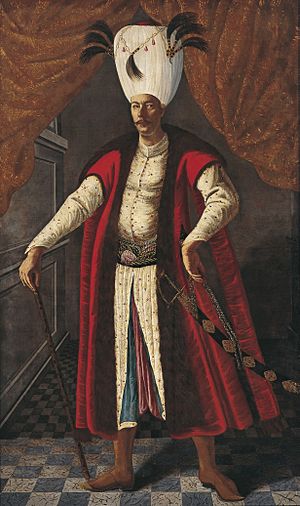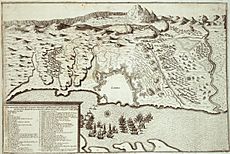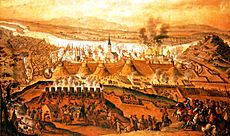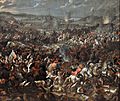Mehmed IV facts for kids
Quick facts for kids Mehmed IVمحمد رابع |
|||||
|---|---|---|---|---|---|
| Sultan of the Ottoman Empire Kayser-i Rûm Custodian of the Two Holy Mosques Ottoman Caliph |
|||||
 |
|||||
| 19th Ottoman Sultan (Emperor) | |||||
| Reign | 8 August 1648 – 8 November 1687 | ||||
| Predecessor | Ibrahim | ||||
| Successor | Suleiman II | ||||
| Regents |
See list
Kösem Sultan
(8 August 1648 – 2 September 1651) Turhan Hatice Sultan (3 September 1651 – 1656) |
||||
| Born | 2 January 1642 Topkapı Palace, Istanbul, Ottoman Empire |
||||
| Died | 6 January 1693 (aged 51) Edirne, Ottoman Empire |
||||
| Burial | New Mosque, Istanbul | ||||
| Consort | Gülnuş Sultan Afife Kadın |
||||
| Issue | see below | ||||
|
|||||
| Dynasty | Ottoman | ||||
| Father | Ibrahim | ||||
| Mother | Turhan Hatice Sultan | ||||
| Religion | Sunni Islam | ||||
| Tughra |  |
||||
Mehmed IV (born January 2, 1642 – died January 6, 1693) was an Ottoman Sultan. He ruled from 1648 to 1687. Mehmed became sultan when he was only six years old. This happened after his father was removed from power.
Mehmed IV is also known as Avcı Mehmet, which means Mehmed the Hunter. He earned this nickname because he loved hunting. He was the second longest-reigning sultan in Ottoman history. His rule saw both difficult times and periods of great success.
Contents
Biography
Early Life and Becoming Sultan
Mehmed was born in 1642 at Topkapı Palace in Constantinople (modern-day Istanbul). His father was Sultan Ibrahim. His mother was Turhan Hatice Sultan. She was a powerful woman who later helped rule the empire.
Mehmed became sultan in 1648 when he was just six years old. This was a very difficult time for the Ottoman dynasty. The empire faced many problems. There were power struggles in the palace. There were also uprisings in different parts of the empire. The Ottoman navy even lost battles to the Venetians.
Because of these challenges, Mehmed's mother gave full power to a wise leader. This leader was Köprülü Mehmed Pasha. He became the Grand Vizier, like a prime minister. Under his leadership, the Ottoman Empire entered a very stable period. This time is known as the Köprülü era.
Mehmed's Reign and Key Events

Mehmed's reign is famous for the return of Ottoman strength. This was thanks to the Grand Vizier Köprülü Mehmed and his son Fazıl Ahmed. They helped the empire win back islands in the Aegean Sea from Venice. They also won the Cretan War (1645–1669).
The Ottomans also had successful military campaigns. They fought against Transylvania in 1660. They also fought against Poland from 1670 to 1674. Ottoman rule expanded into new areas like Podolia.
Later, another vizier, Merzifonlu Kara Mustafa, led campaigns against Russia. He captured Chyhyryn in 1678. He also supported a Hungarian uprising against Austrian rule. This led to a huge Ottoman army marching to Vienna.
The Great Turkish War
In 1683, the Ottomans besieged Vienna. However, at the Battle of Vienna, they suffered a major defeat. Polish and Austrian forces, led by King John III Sobieski, attacked them. This battle was a turning point.
After this defeat, the Great Turkish War began. The armies of the Holy League started pushing the Ottomans back. They aimed to reclaim lands in the Balkans.
End of Mehmed's Rule and Later Life
After another defeat at the Battle of Mohács (1687), the Ottoman Empire faced a big crisis. Soldiers became unhappy and rebelled. In November 1687, it was decided to remove Sultan Mehmed IV from power. His brother, Suleiman II, became the new Sultan.
Mehmed was then held at Topkapı Palace. He was allowed to leave the palace sometimes. He died in Edirne Palace in 1693. He was buried in the New Mosque in Constantinople, near his mother's tomb.
Mehmed's favorite partner was Gülnuş Sultan. She was a slave girl who later became his wife. They had two sons, Mustafa II and Ahmed III. Both of them later became Ottoman Sultans.
Family
- Consorts
- Gülnuş Sultan
- Afife Kadın
- Sons
- Mustafa II (born 1664 – died 1703) – son with Gülnuş Sultan
- Ahmed III (born 1673 – died 1736) – son with Gülnuş Sultan
- Şehzade Bayezid (born and died 1678)
- Daughters
- Hatice Sultan (born 1668 – died 1743) – daughter with Gülnuş Sultan
- Ümmügülsüm Sultan (born 1672 – died 1700) – daughter with Gülnuş Sultan
- Fatma Sultan (died 1700) – daughter with Gülnuş Sultan
Images for kids
-
Painting depicting the Battle of Vienna of 1683 by Gonzales Franciscus Casteels.
See also
 In Spanish: Mehmed IV para niños
In Spanish: Mehmed IV para niños







